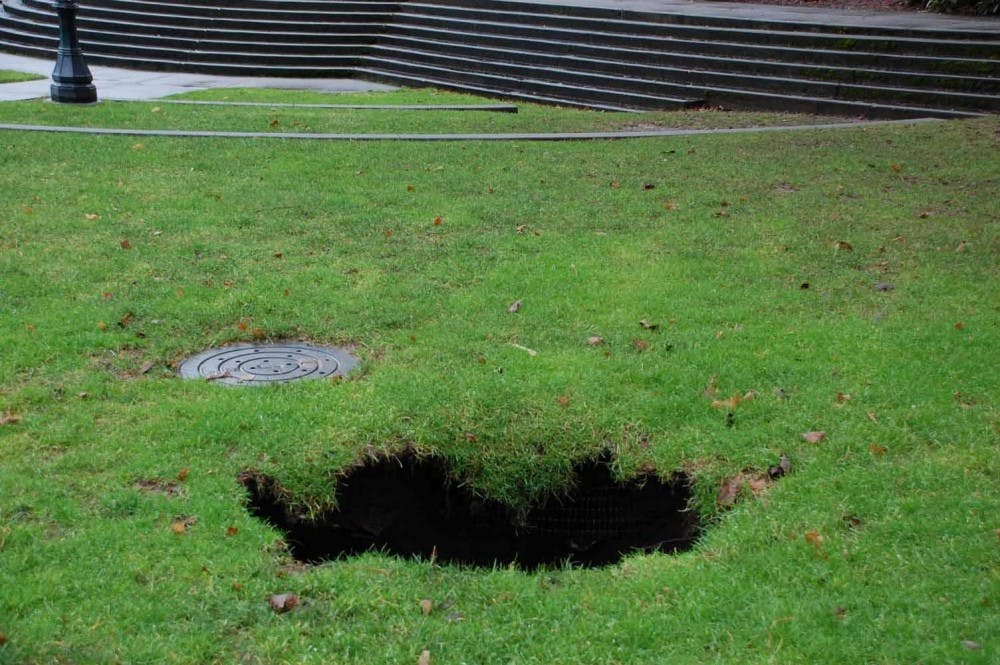(Photo Submitted by Fr. Ron Wasowski)
By Joanna Goodwin, Staff Writer -- goodwin12@up.edu
At the beginning of the semester, the area in front of Franz Hall turned into an obstacle course filled with hoses, pumps, dirt piles and caution tape.
On Jan. 13, a three-foot wide spot right next to the manhole in front of Franz Hall dropped four feet, giving way to a cavity known as a sinkhole.
Paul Luty, director of facilities planning and construction, was one of the first people to know about the sinkhole. He was determined to find the source of the problem.
"The campus is old and infrastructure dates to the 1800's," Luty said as he explained why these kinds of things happen on campus.
"In the past, the clay terracotta pipe from Buckley Center to Franz Hall used as rainwater drainage has had problems with plugging," Luty said.
Roto Rooter has noticed these problems with many pipes on The Bluff, keeping Physical Plant workers busy.
"The pipes around campus have been going through a concrete lining process," Luty said. "They will replace the old clay pipes with new concrete pipes that will last a lot longer."
This procedure has already been completed with the sewage pipes from The Commons to the pump house and was on the agenda for other pipes nearby.
Because the pipes in front of Franz Hall were not redone, the sinkhole formed.
Fr. Ron Wasowski, C.S.C., was the one who discovered the sinkhole.
"I was walking from my apartment and I looked over and there was a hole in the ground," Wasowski said. "It was about three feet wide, five feet long and six feet deep when I found it. Just by chance a Physical Plant worker was walking by, and I asked him if he knew about this sinkhole."
"All of a sudden, whereever there is a lot of water in a pipe that is cracked, the void will get bigger," Luty explained. "With all of the rain lately, it makes the problem worse."
This isn't the first time this kind of thing has happened on campus.
"A year ago, there was an even larger sinkhole in the parking lot of Physical Plant that sunk a corner of a car," Luty said.
There was so much damage they ended up replacing over 30 feet of the pipe that carried rainwater and sewage from all over campus.
"This was with total costs to over $130,000," Luty said.
According to Luty, in order to fix the most recent sinkhole, Physical Plant got a $5,000 estimate from the same company that fixed the last sinkhole.
Roto Rooter diverted rain water and crews dug five to six feet to remove the broken pipe and put in a new one.
Although the problem is fixed now, Wasowski still expressed concern.
"The earth-moving machine they brought out to fix it drove over the sidewalk by the pipe and broke it into almost eight pieces. This may have cracked more of the same pipe causing the problem to happen again," Wasowski said.
Sinkholes 101
There are two kinds of sinkholes that can be formed. One type occurs due to geological factors. The other kind is confused by deteriorating pipes. The eroding pipes were in front of Franz were most likely built to last 50 years, and that was 60 years ago.
These pipes, over time, begin to decay and crack; space is then opened up for soil to be deposited inside of the pipe.
When it rains, the soil gets set into the damaged pipe and carries more and more soil through the pipes and away from the surroundings of the pipe.
Over time, the surface drainage, erosion and deposited soil turn the space into an overarching cavity above the pipe.
Eventually the ground surface collapses into the cavity, creating a sudden sinkhole.
Sinkhole step by step
A clay terracotta pipe is set into the ground for storm water 50-60 years ago.
These pipes, over time, begin to decay and cracks. Space is then opened up for soil to be deposited inside of the pipe.
When it rains, the soil gets set into the damaged pipe and carries more and more soil through the pipes and away from the pipe's surrounding area.
Over time, the surface drainage, erosion and deposited soil turn the space into an overarching cavity above the pipe.
Eventually, the ground surface collapses into the cavity, creating a sudden sinkhole.
(Illustrations by Samantha Heathcote -- The Beacon)
(Illustrations by Samantha Heathcote -- The Beacon)
(Illustrations by Samantha Heathcote -- The Beacon)
(Illustrations by Samantha Heathcote -- The Beacon)
(Illustrations by Samantha Heathcote -- The Beacon)





